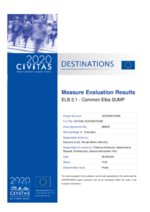
Elba (Italy)
With its 224 km2, Elba is the 3rd largest Italian island, located around 10 km away from the Tuscany region’s coast, in the Thyrrenian Sea. It is the biggest island of the Tuscan Archipelago National Park, which also includes the islands of Pianosa, Capraia, Gorgona, Montecristo, Giglio, and Giannutri. Elba features a very heterogeneous territory, with 1,000m high mountains on the west, an eastern hilly territory, and a central flat area where the most populous urban centres are located. It is divided into seven municipalities, among which Portoferraio and Rio host the main ports connecting the island with the mainland.
The Elba Island suffers from a high tourist seasonality, especially in the summer, when the share of tourists can reach an average 80-85% of the entire population, causing significant variations in the demand for public transport services.
Several challenges affect the island’s mobility and accessibility, such as the concentration of ferry arrivals/departures in Portoferraio (the main harbour), resulting in traffic congestion on the road network. Moreover, the use of private cars by residents and tourists is very high (80%), causing traffic and parking problems, especially in the inner-city centres. In addition, the use of public transport services is quite low (14% of the overall PT offer), which contributes to the increase of road congestion, CO2 emissions, acoustic pollution, and parking problems. Finally, the mobility offer is fragmented in terms of ticket retailers, information providers, marketing, and accessibility, thus proving ineffective to comply with the needs of tourists and residents.
Fast Facts
31,904 (2019)
Population
143.07 inhabi./km2
Population density
Elba after DESTINATIONS
- Cleaner and more efficient public and private fleets
+ 7 new e-charging stations, in May 2021;
- 4% freight vehicles circulating between 2016 and 2020;
Elba Shared Use Mobility Agency to improve the use of sharing mobility in 2021;
5 new cleaner buses in the local PT fleet and 2 new EURO VI buses available only in the summer, between 2018 and 2020. - More attractive public transport (PT)
+ 20% users’ satisfaction towards traditional PT services in 2019;
+ 67% users’ satisfaction for additional Rio and Portoferraio PT services in 2019;
+ 18.000 passengers with additional PT services, between 2017 and 2020; - Safer and more accessible public spaces
4 sites with new road crossings/sidewalks in Portoferraio, 2018 to 2019;
3 sites with new road crossings/sidewalks in Rio, 2018 to 2019;
80% citizens and tourists very satisfied with the increased safety of road crossings in 2020;
80% pedestrians and cyclists very satisfied with the increased safety and accessibility in 2020. - Hoteliers and local businesses as ambassadors of sustainable mobility
11 hoteliers involved in a long-term rental of e-bikes for experimental purposes, in 2018;
40 e-bikes rented by hoteliers in a long-term formula for their guests, 2018 to 2019;
9 hoteliers involved as local PT tickets vendors, 2018 to 2019; - Outlined strategic Plans – Elba SUMP (Sustainable Urban Mobility Plan) and SULP (Sustainable Urban Logistic Plan) – approved by Portoferraio and Rio, and taken into consideration as official documents for the long-term commitment to find common sustainable solutions to the complex mobility issues of the island.
Future activities
Portoferraio and Rio will continue to work together beyond DESTINATIONS, also strengthening the dialogue with the other 5 municipalities of Elba, building on the legacy of the project’s pilots, scaling-up and exporting the most successful activities.
The strategic actions included in the SUMP and SULP are part of the political agenda of the municipal and provincial authorities. The local partners will continue to promote sustainable mobility by:
- involving local communities, as well as public and private stakeholders, to implement coordinated mobility planning;
- improving the innovative technological tools managing the mobility demand on the island;
- providing improved information to residents and tourists.
















